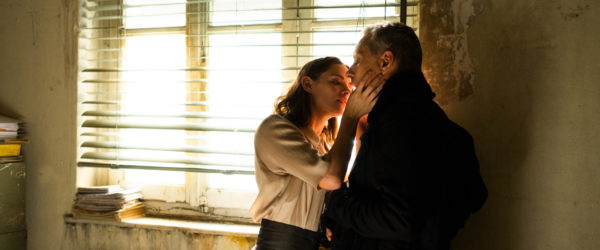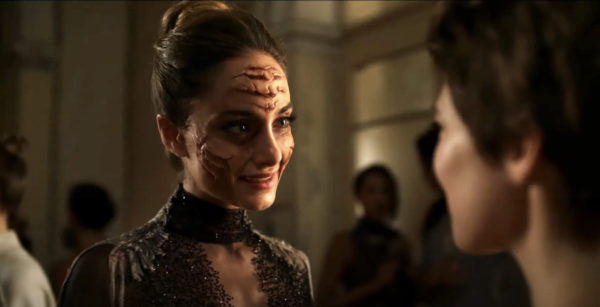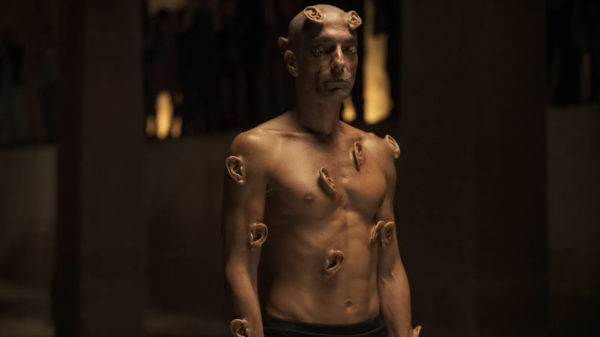
After a long eight year absence, David Cronenberg finally debuted a new film in 2022: Crimes of the Future. Here’s a review of the film, now out on DVD, Blu and 4k.
The Film: Set in an indeterminate grimy dystopian future, the Athens-shot film follows two artists – Saul Tenser (Viggo Mortensen) and Caprice (Léa Seydoux) – who profit off of their surgery-related performance art. Tenser has “accelerated evolution syndrome,” so he is physically affected by new organ growths that Caprice extricates for a paying public of voyeurs.
Their novelty and market share is at risk, however, now that no one is capable of feeling any pain and body modifications – both natural and surgical – are routine, as evidenced by other artists such as Tassos Karahalios’ Klinek.
As they are investigated by officers Wippet and Timlin from the National Organ Registry (Don McKellar and Kristen Stewart), Tenser and Caprice become ensnared with a political uprising involving radical evolutionists, undercover police officers, and Lang Dotrice (Scott Speedman), the father of a dead boy who is nothing if not enterprising.

The Review: Working as a kind of defacto sequel to eXistenZ, Crimes of the Future takes place in a run-down, grimy world. The original script, which borrows the titles of one of his earliest works, but bears little resemblance to it, deftly balances the usual Cronenberg themes of art vs science, body horror, and philosophical musings about suffering, bureaucracy, human connection and sex.
It’s a heady mix that is less playful than its spiritual predecessor, although there’s a dark humour in several scenes (particularly Tenser’s struggle with his eating chair). Several of the performances are highly memorable, especially Stewart’s, whose Timlin has a halting cadence and a naïve sexuality that is perplexing, endearing and infectious. Her burgeoning obsession with Tenser is initially born out of respect for his work, but ends up bordering on infatuation, culminating in the memorable scene where she propositions him for sex in her office.
It is the relationship between Seydoux and Mortensen that is the bedrock of the film, however. Partners in multiple senses of the word, they have a fascinating interplay as Caprice struggles for independent recognition of their art while also confronting the growing rift between them. The role demands a different kind of performance from Mortensen: Tenser is in constant pain so the actor is less spry than his other Cronenberg collaborations, but he makes up for it by highlighting the agony of Tenser’s daily regiment.

As Cronenberg’s quote/unquote “return” to the subgenre of horror that he made famous in the eighties, Crimes of the Future is undeniably more art house than gore fest. With that said, the performance pieces, Klinek the multiple-eared man, and the climactic child autopsy scene are all visually compelling or deeply unsettling.
While the film overall lacks some of the visceral power of his earlier body horror films, Cronenberg – like Tenser – has become increasingly contemplative as he grows older and the film’s philosophical consideration of the intersection between art, revolution and evolution is wholly fascinating.
Like eXistenZ, the world-building in the film is both grand and small. Crimes of the Future sometimes feels claustrophobic in its set design; at times it seems as though the film is composed of a single street and a few interiors. And yet the implication of what has occurred with regards to human evolution, laid out in the opening scene – wherein young Brecken (Sotiris Sozos) eats a garbage bin and is subsequently suffocated for it – offers a sense of the tension and fear that accompanies the emergence of a new breed of humans.
There’s a visual connection to Snowpiercer, a gentle condemnation of how social media has changed the art and beauty industries, and some truly fantastic prop work in Tenser’s feeding chair and the surgery pod/bed he uses for shows. While the cop/terrorism storylines feel undercooked and probably needed additional screen time (or to be excised entirely), Crimes of the Future contains no shortage of tantalizing components.
Whether they work within the narrative of the film or are better suited for post-screening debates over drinks, however, is another question.

The Special Features: Sadly, there’s only one notable extra on the disc besides the film’s teaser and Red Band trailer, and that’s a brief making of featurette.
It’s more of an amuse bouche than anything; a series of quick interviews with most of the main cast about the themes of the film, followed by praise and excitement for Cronenberg (it’s more about working with him than the film itself). Alas, considering the topical themes of the film and the eight-year absence since the famed Canadian director’s last film, a more robust set of extras or even a commentary would have been very welcome.
- Film Rating: 3.5/5
- 4K Extras Rating: 1/5
Perfect description of the film I just watched. Right down to the exceptional Stewart scene. Only thing missing, as it was in the original film, is a mention of the performance artists in which its inspiration is based. Most notably Stellarc (ears) and Ron Athey (tattoos and cutting). Always culturally awkward when mainstream (yes, Cronenberg is mainstream) appropriates ideas/themes/images from less culturally privileged artists like the ones just mentioned without attribution.